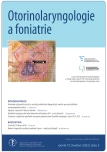Comparison of mutual associations and sensitivity of individual diagnostic methods in the process of identification of extraesophageal reflux
Authors:
K. Lukáčová 1
; Z. Javorská 2
; Miroslav Tedla 2
Authors‘ workplace:
ORL klinika, FNsP Nové Zámky
1; Klinika otorinolaryngológiea chirurgie hlavy a krku LF UK a UN Bratislava
2
Published in:
Otorinolaryngol Foniatr, 72, 2023, No. 2, pp. 58-64.
Category:
Original Article
doi:
https://doi.org/10.48095/ccorl202358
Overview
Introduction: Extraesophageal refl ux is relatively common in ENT outpatient offi ces. The aim of the study is to compare the mutual associations and sensitivity of individual dia gnostic methods in the process of identifi cation of extraesophageal refl ux (Refl ux Symptom Index – RSI, Refl ux Finding Score – RFS, oropharyngeal pH-metry RESTECH Dx-pH System, dia gnostic-therapeutic test – DTT). Material and methods: The study included 30 patients. In 20 of them refl ux was demostrated by oropharyngeal pH-metry, in 10 the pH-metry was negative. Each patient completed an RSI questionnaire, underwent video-laryngoscopic examination, oropharyngeal pH measurement RESTECH Dx-pH System and dia gnostic-therapeutic test using proton pump inhibitors for 3 months regardless of the result of oropharyngeal pH-metry. The tolerance of the oropharyngeal pH-metry RESTECH Dx-pH System was investigated. Another aim was to capture the main trends in the data using descriptive analysis and to obtain general conclusions about the internal relations between individual dia gnostic methods and patient characteristics using inferential analysis. Results: The tolerance of oropharyngeal pH-metry RESTECH Dx-pH System in our patient group was 97.14%. Correlation indices indicate negligible or only very weak associations between the results of individual methods. Based on inference analysis performed by estimating the incidence, up to three double combinations showed the same degree of positivity (82,90%; 95% CI 70,5–95,3%). Namely, they are RSI × DTT, RFS × DTT and pH-metry × DTT. Conclusion: The RESTECH Dx-pH System – oropharyngeal pH-metry is a suitable dia gnostic method in combination with other methods used in the dia gnosis of esophageal refl ux due to the good tolerance by patients. However, its separate use in the dia gnosis of EER is questioned in several other works which can be considered a limitation of the work. The parallel use of subjective and objective dia gnostic methods in combination with a dia gnostic-therapeutic test is a sensitive way of identifying patients with extraesophageal refl ux.
Keywords:
oropharyngeal pH-metry – diagnostic-therapeutic test – Reflux Finding Score – Reflux Symptom Index – extraesophageal reflux
Sources
1. Ďuriček M, Bánovič P, Haličková T et al. Pohľad gastroenterológa na laryngofaryngeálny refl ux. Gastroenterológia pre prax 2015; 14(2): 57–62.
2. Brandtl P, Lukáš K, Turzíková J et al. Extraezofageální refl uxní choroba – mezioborový konsenzus. Otorinolaryngol Foniatr 2011; 60(2): 63–70.
3. Klinkenberg-Knol E. Otolaryngologic manifestations of gastro-oesophageal refl ux disease. Scand J Gastroenterol Suppl 1998; 33(225): 24–28. Doi: 10.1080/ 003655298750027173.
4. Koufman JA. Laryngopharyngeal reflux is diff erent from classic gastroesophageal refl ux disease. Ear Nose Throat J 2002; 81(9 Suppl 2): 7–9.
5. Zeleník K. Defi nice základních pojmu, historie a epidemiologie. In: Mimojícnové projevy refl uxní choroby. 1. vyd. Praha: Tobiáš 2013: 64–73.
6. Johnston N, Dettmar PW, Bishwokarma B et al. Activity/ stability of human pepsin: implications for refl ux attributed laryngeal disease. Laryngoscope 2007; 117(6): 1036–1039. Doi: 10.1097/ MLG.0b013e31804154c3.
7. Zeleník K, Komínek P, Stárek I et al. Extraezofageání refl ux (2. část). ORL manifestace a léčba. Otorinolaryngol Foniatr 2008; 5(3): 151–158.
8. Wiener GJ, Tsukashima R, Kelly C et al. Oropharyngeal pH monitoring for the detection of liquid and aerosolized supraesophageal gastric reflux. J Voice 2009; 23(4): 498–504. Doi: 10.1016/ j.jvoice.2007.12.005.
9. Fossmark R, Johnsen G, Johanessen E et al. Rebound acid hypersecretion after longterm inhibition of gastric acid secretion. Aliment Pharmacol Ther 2005; 21(2): 149–154. Doi: 10.1111/ j.1365-2036.2004.02271.x.
10. Zeleník K. Úloha mimojícnového refluxu v etiopatogenezi onemocnění horních cest dýchacích. 2018 [online]. Dostupné z: https:/ / dspace.cuni.cz/ bitstream/ handle/ 20.500.119 56/ 111981/ H%C5%98%20MUDr.%20Zelenik %20EER%20prace%20FINAL%20bez% 20priloh%202%20verze_ke_zve%C5%99 ejn%C4%9Bn%C3%AD.pdf?sequence=7&is Allowed=y
11. Mesallam TA, Stemple JC, Sobeih TM et al. Reflux symptom index versus reflux finding score. Ann Otol Rhinol Laryngol 2007; 116(6): 436–440. DOI: 10.1177/ 000348940711600608.
12. Gelardi M, Silvestri M, Ciprandi G et al. Correlation between the refl ux fi nding score and the refl ux symptom index in patients with laryngopharyngeal refl ux. J Biol Regul Homeost Agents 2018; 32(1 Suppl. 2): 29–31.
13. Mallikarjunappa AM, Deshpande GA. Comparison of Reflux Symptom Index (RSI) with Reflux Finding Score (RFS) and Its Effectiveness in Dia gnosis of Laryngopharyngeal Refl ux Disease (LPRD). Indian J Otolaryngol Head Neck Surg 2022; 74(Suppl 2): 1809–1813. Doi: 10.1007/ s12070-020-01814-z.
14. Zeleník K, Kopřivová H, Komínek P. Extraezofageální reflux: porovnání základních diagnostických metod (Reflux symptom index, Refl ux fi nding score, dia gnosticko – terapeutický test, pH-metrie). Otorinolaryngol Foniatr 2011; 60(2): 71–77.
15. Becker V, Drabner R, Graf S et al. New aspects in the pathomechanism and dia gnosis of the laryngopharyngeal refl ux-clinical impact of laryngeal proton pumps and pharyngeal pH metry in extraesophageal gastroesophageal refl ux disease. World J Gastroenterol 2015; 21(3): 982–987. Doi: 10.3748/ wjg.v21.i3.982.
16. Becker V, Graf S, Schlag C et al. First agreement analysis and day-to-day comparison of pharyngeal pH monitoring with pH/ impedance monitoring in patients with suspected laryngopharyngeal reflux. J Gastrointest Surg 2012; 16(6): 1096–1101. Doi: 10.1007/ s11605-012-1866-x.
17. Rees CJ, Belafsky PC. Laryngopharyngeal refl ux: Current concepts in pathophysiology, dia g - nosis, and treatment. Int J Speech Lang Pathol 2008; 10(4): 245–53. Doi: 10.1080/ 175495007 01862287.
18. Postma GN. Ambulatory pH monitoring methodology. Ann Otol Rhinol Laryngol Suppl 2000; 184: 10–14. Doi: 10.1177/ 0003489 400109s1003.
Labels
Audiology Paediatric ENT ENT (Otorhinolaryngology)Article was published in
Otorhinolaryngology and Phoniatrics

2023 Issue 2
Most read in this issue
- Cochlear implantation as a solution for unilateral deafness in children – first experience
- Experiences with the objective examination of swallowing using the flexible endoscopy in the years 2014–2021
- Hearing loss in patients with Fabry disease
- Comparison of mutual associations and sensitivity of individual diagnostic methods in the process of identification of extraesophageal reflux
